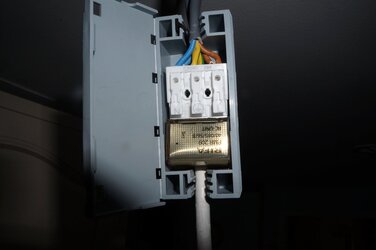F
feisar32
Hi all
Hoping someone might be able to advise. I've got two sets of LED lighting this is affecting. One is the plinth LEDs I originally raised a thread for some months back; one is two LED wall lights.
The problem I have is that, when the lights are off, they flash briefly every ten seconds (in the case of the plinth LEDs) and every twenty(ish) seconds in the case of the farthest LEDs wall lamp. Both sets of lights are switched; the wall lamps are switched individually, and can be switched from the three-way switch nearest the door, or from a single switch under each lamp. The plinth LEDs are switched both via a presence detector, and can be overridden by a standard grid-switch module
When I did some Googling, there was a thread I found elsewhere that suggested "[..] you can usually check for a small voltage on the switched live wire. If the circuit has two-way switching, this voltage will be more apparent on one of the "off" configurations rather than the other. Adding a suppressor (or snubber) to the circuit between the switched live and the neutral will solve the problem".
My brother-in-law is an electrician, but he says he's never heard of suppressors or snubbers. I wondered whether this issue sounds familiar to any of you and if so, whether the suppressor or snubber is the correct solution?
When I Googled snubbers, what I got back as an example was something like a "Danlers Low Load Capacitor for Low Energy Lamps" ... would that be the right sort of thing ... ?
One other query as well, if I may: anyone know of any 24v LED strip with a 50mm cut-point ... ? Or is it only 12v strip that can be put at those intervals?
Thanks in advance ...
Hoping someone might be able to advise. I've got two sets of LED lighting this is affecting. One is the plinth LEDs I originally raised a thread for some months back; one is two LED wall lights.
The problem I have is that, when the lights are off, they flash briefly every ten seconds (in the case of the plinth LEDs) and every twenty(ish) seconds in the case of the farthest LEDs wall lamp. Both sets of lights are switched; the wall lamps are switched individually, and can be switched from the three-way switch nearest the door, or from a single switch under each lamp. The plinth LEDs are switched both via a presence detector, and can be overridden by a standard grid-switch module
When I did some Googling, there was a thread I found elsewhere that suggested "[..] you can usually check for a small voltage on the switched live wire. If the circuit has two-way switching, this voltage will be more apparent on one of the "off" configurations rather than the other. Adding a suppressor (or snubber) to the circuit between the switched live and the neutral will solve the problem".
My brother-in-law is an electrician, but he says he's never heard of suppressors or snubbers. I wondered whether this issue sounds familiar to any of you and if so, whether the suppressor or snubber is the correct solution?
When I Googled snubbers, what I got back as an example was something like a "Danlers Low Load Capacitor for Low Energy Lamps" ... would that be the right sort of thing ... ?
One other query as well, if I may: anyone know of any 24v LED strip with a 50mm cut-point ... ? Or is it only 12v strip that can be put at those intervals?
Thanks in advance ...










